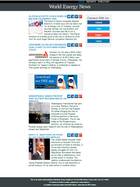Oil below $60 puts US producers in a tough position regarding growth and capital returns
Analysts have warned that a drop in oil prices to below $60 per barrel as a result of an intensifying trade war could cause anxiety throughout the U.S. Oil Patch, forcing companies to take additional measures, including reducing share buybacks or capital expenditures.
Brent crude and West Texas Intermediate futures (WTI) fell to their lowest levels since February 2021 as tariffs introduced by U.S. president Donald Trump raised fears of a possible recession due to signs of increased supply from major producers.
Pavel Molchanov, an analyst at Raymond James, said that some producers may reduce their 2025 capex spending if the recession persists. However, broader cuts would depend on the severity and duration of this downturn.
Share buybacks are typically a 'flexible variable' which can be easily adjusted depending on the amount of free cash flow generated.
Exxon Mobil cut capital expenditures by 30% during the COVID-19 crash of 2020 when oil demand fell and prices briefly went negative. Chevron also reduced its budget by $4 Billion and stopped its buyback program.
ConocoPhillips also cut spending and stopped repurchases.
Oil companies have become more leaner, but higher costs for service and the energy transition has reduced their financial buffers.
Expecting BREAKEVEN
Although many operators are able to benefit from the low breakeven cost of the Permian Basin, which is expected contribute nearly all the U.S. Lower 48 production growth in this year, paying high dividends puts financial pressure on companies that work in less profitable and more expensive oil fields.
Rystad Energy believes that many U.S. producers of oil are now facing breakeven prices over $62 per barrel. This includes dividends, debt servicing, and return target.
Matthew Bernstein is vice president at Rystad. He said that margins will be protected by sacrificing a combination of short-term activity, investor payouts, or inventory preservation.
As margins tighten, the crude slump has brought new scrutiny to U.S. Oil and Gas firms' plans for maintaining shareholder returns.
RBC Capital Markets calculates Exxon's breakeven point to cover dividends and buybacks at $88 per barrel in 2025. Chevron is even more expensive, at $95 a barrel.
Bernstein stated that "the corporate reality of public players is that modest growth may be threatened if oil prices stay near $60 per barrel."
The earnings reports due later this month should provide insight as to whether producers are likely to continue on the current path or shift towards cash conservation.
We'll see how we stand at the end April and beginning May in terms of whether companies will cut their capex or do buybacks. "We'll see where we are at the end of April and early May as to whether companies would cut capex or buybacks," said Arjun Murati, a partner with energy consultancy Veriten.
(source: Reuters)

